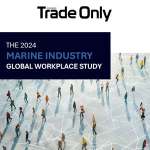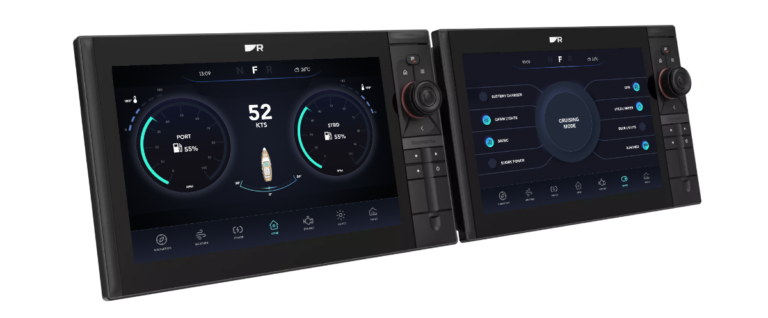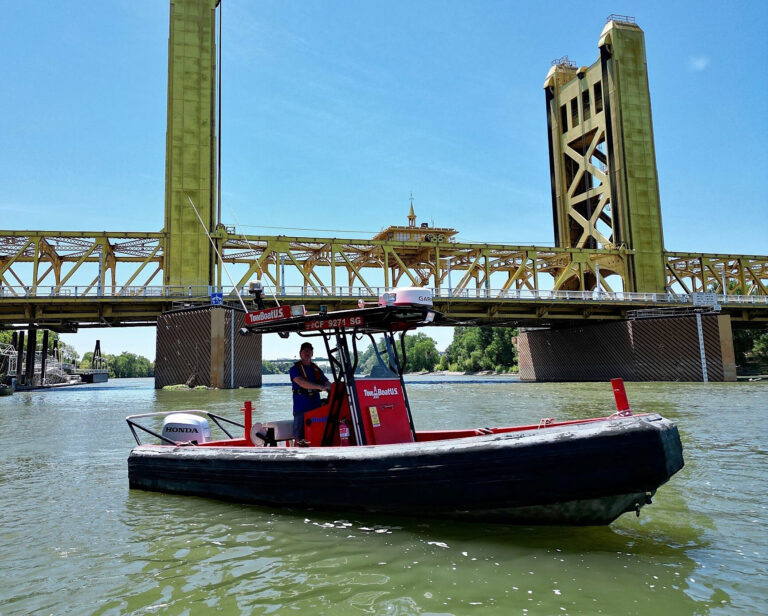
Back Cove Yachts had planned to unveil its 39-foot, outboard-powered model at the Newport International Boat Show in September. The show was canceled because of the coronavirus pandemic, but even if it had gone on, Back Cove wouldn’t have been ready to unveil the boat.
Like manufacturers across all sectors, the Maine boatbuilder is grappling with lingering production delays following mandatory manufacturing shutdowns across the country, followed by shutdowns in areas with Covid-19 flare-ups. While consumer demand remains strong for boats, the overall supply chain is strained, and a widespread workforce shortage has been compounded by federal unemployment programs that, some builders say, incentivize workers to stay home.
Back Cove and its sister company, Sabre Yachts, report being at about 70 percent capacity, not only because of all those challenges, but also because of new distancing guidelines at the plant, further slowing production. “The supply chain side is choppy at best,” says Back Cove CEO Jason Constantine.
On top of all that, hangups in international shipping and domestic trucking have further delayed OEMs awaiting components. Some 73 percent of marine manufacturers report order backlogs, and many also say supplier deliveries are slower than they were last year, says Vicky Yu, business intelligence director for the National Marine Manufacturers Association, citing an NMMA survey of more than 200 marine manufacturer CEOs.
Of those surveyed, 58 percent said they were experiencing supply chain disruptions — a marked improvement over the first-quarter survey, when 71 percent faced disruptions, but still a majority of the industry.
“While there has been some improvement, there are some supply chain effects still,” Yu says. “We asked, ‘How do new orders look?’ The results were pretty mixed. Where there were just about the same number of people saying they were getting a lot of new orders, there were about same amount of people saying they weren’t.”
Manufacturers’ inventory also appears to be in flux; the average amount of inventory on hand was 12 to 16 weeks, “but that spread is high,” Yu says. “Some are saying they’re already out of inventory; others are saying they have inventory for three months.
“I think we’re fortunate that we’re in an industry that there are some positives,” she adds, “but really, everyone is suffering through all of this.”

No Components, No Boats
“The retail sales during May and June were like nothing I have ever experienced,” says Correct Craft CEO Bill Yeargin, adding that most of his company’s brands are scheduled out until next spring. “It was great for the dealers, as they sold their products, and will be good for manufacturers this fall and winter as the dealers restock.”
But federal unemployment benefits from legislation like the CARES Act have been so high that they are creating problems in getting furloughed employees back to work, Yeargin says. “Clearly, something needed to be done to help people, but the administration and Congress created a disincentive to work,” he says.
Some suppliers also struggled to restart production because they had key employees out sick with Covid-19, Yeargin says. And the employees who were available couldn’t always get the right components to do their jobs. “When we don’t have key components, boats can’t be built. It’s that simple,” Yeargin says. “In some cases, we can add the component on after building the rest of the boat, but in other cases the boat cannot be built.”
The combination of workers being out and key components missing has created a shortage of boats at a time when demand is higher than dealers say they’ve ever seen it. “We certainly know that some manufacturers are a year out; they’ve got a year’s worth of orders to fill right now,” says Matt Gruhn, president of the Marine Retailers Association of the Americas. “Some of that’s [because] they’re waiting on supply chain parts and so forth, and some of it’s just Covid demand. It’s just crazy. Manufacturers are building mostly retail-sold boats right now. Everywhere you look, we need more boats, and that’s what we’re trying to do is ramp up and fill orders we have and replenish inventory levels.”
Covid Crossover
In addition to the supply-side challenges, consumer spending and demand have shifted to a far narrower swath of goods, creating inventory shortages in sectors that intersect with popular pandemic activities. For example, a spate of home improvements has strained kitchen appliance inventory — often the same products used in boats.
“Appliances are hard to get because everybody’s renovating their kitchens,” says Aaron Crawford, CEO at Sabre Yachts. “Something as simple as latex gloves, they’re critical for first responders, but they also use latex in mattresses and other things in boats.”
Crawford estimates a 30 to 40 percent reduction in capacity and production of wholesale shipments.
“The benefit of being in business for 50 years is, we have good relationships with key suppliers. We’ve had very transparent conversations and used our projections … so they can plan accordingly,” he says. “But it pushed out lead time. Things that were four to eight weeks out are now 12.”
The ongoing challenges are causing hesitation. Although manufacturers are optimistic about the surge in boat sales, they’re also being cautious with capital expenditures, Yu says.
“We see they’re holding back on fixed assets so they can remain nimble through this,” she says.

Capacity and Staff
The fact that 81 percent of manufacturers are reporting full compliance with distancing guidelines is encouraging, Yu says, but that distancing along with the workforce shortage is slowing productivity.
Prior to the pandemic, “we had finally had gotten over years of labor shortages,” says Bentley Collins, vice president of sales and marketing for Sabre and Back Cove. In Maine, he says, people are now earning $21 an hour on unemployment. “When we came back, we haven’t succeeded in getting everybody back. The difficulty in finding labor today seems as hard, if not harder, than a couple years ago.”
The higher-than-usual unemployment checks are challenging, but that situation tends to even out at a macro level, Yu says.
“The disincentives become second or third order, though they’re very real for manufacturers dealing with them,” Yu says. “But it’s so necessary to have these measures in place to help those people that are really suffering and really need it.”
And even if Sabre and Back Cove could find extra workers, there wouldn’t be enough supply and capacity with distancing regulations to ramp up production anyway.

Shortages and Delays
Delays can come from every aspect of the production process. Suppliers that are making their actual product without delay can be waylaid by inability to get packaging, while others are having trouble sourcing specific commodities — say, a mineral from India needed to produce a particular compound, Constantine says.
Consequently, Back Cove and Sabre are carrying more inventory in-house to make sure they don’t have production interruptions. “For six to eight weeks, we were moving through inventory we had in stock, but we’ve moved through that,” Constantine says. “The suppliers have now moved through their materials, and moved on to B and C suppliers.”
That means someone, or several people, has to spend time finding a substitution, which in some cases means a product that’s been off the shelf for years, he says.
“It’s been much more of a struggle for our purchasing teams because it’s something new,” Constantine says.
For example, the company that used to supply plumbing hoses closed its distribution center in the South, so Back Cove had to source the components locally and pay retail for them.
“We spend a tremendous amount of time chasing non-value-added items and details,” Constantine says.
Kurt Forsman, president of the Derema Group, a distributor and manufacturer of marine and RV products, says all of his company’s vendors — OEM and aftermarket, distribution and retail — are getting parts everywhere they can, from big-box stores to mom-and-pop shops. The scramble has created what Forsman calls “ghost orders” for things like trailers: dealers placing orders with multiple manufacturers and then canceling all but one, prompting manufacturers to charge 50 percent of the order up front.
There has also been panic buying. Derema Group has seen a 32 percent increase in antifreeze sales — “just huge in the number of gallons,” Forsman says — as dealers try to anticipate the increase in the number of boats they’ll need to winterize.
Although manufacturers are having no problem producing more antifreeze, they need the right economies of scale to order sleeves and labels, to maintain the right pricing for end users.
“They have to produce a quarter-million labels to be at the right pricing,” Forsman says. “And then you can’t just spin them out tomorrow. You have to get in a production line to have that done.”

Slow Delivery
Trucking and shipping delays have also added difficulties in getting products to OEMs, dealers, distributors and consumers. “Things coming internationally will be interrupted at the border, or they’re not able to get ships back and forth,” Constantine says.
A trucking and driver shortage has also made it difficult to replenish inventory, according to The Wall Street Journal, which reported in September that two major trucking companies said tonnage on their trucks was up in the first weeks of the third quarter, while tight capacity and improving demand were driving prices on trucking’s spot markets to their highest levels of the year.
Then the U.S. Department of Transportation recommended truck inspections after ceasing them in March, creating a sort of “national checkpoint” over Labor Day weekend, Forsman says. “That took a ton of trucks off the road as well because many had to fix those little things they had neglected to fix.”
Capacity has been so tight, Forsman says, that one automotive distributor was deciding what to deliver based on profit margins. “That has this ripple effect on the whole community,” he says. “Now the next distributor’s demand goes up. It skews how you play it. You’ve got to look at how you aggregate all this new information.”
To add yet another challenge, states have differing quarantine rules for crossing state lines, Collins says. One driver in Maine was going to deliver a boat, but he had to quarantine in the state for two weeks at drop-off, and then quarantine again when he came back.
In another example, a used Back Cove 41 from Newfoundland took three different captains to get to Portland, Maine, because of border-crossing regulations. All the normal metrics are being thrown out, making prognostication for the future especially tough. “It’s just this uncharted territory,” Forsman says.
This article was originally published in the October 2020 issue.











